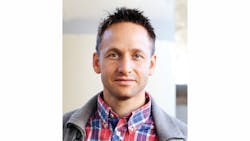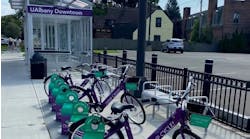As a community planner with the Federal Transit Administration, Eric Eidlin has continued his longtime passions for sustainable transportation and sustainable urban development. His management portfolio of projects include such mega-projects as the $2.3 billion BART to San Jose Extension and the $1.9 billion Transbay Transit Center Project.
Eidlin also has a special function in the office as the sustainability coordinator to the Federal Partnership for Sustainable Communities (PSC). Through his PSC activities, Eidlin spearheaded the creation of a working group focusing of the identification and development of policies and programs in the San Francisco Bay Area that integrate transportation and land use with the potential of serving as a national model. The group recently published a report showcasing more than 100 policies, tools and projects that aim to overcome barriers to housing and transportation coordination. His exemplary leadership and contributions resulted in his receipt of the FTA’s Award of Special Merit in 2011, one of the FTA’s highest honors.
Eidlin also served as a key member of the city of Fresno’s Strong Cities Strong Communities (SC2) team. SC2 is a White House Initiative that aims to create new partnerships among federal agencies and distressed cities to spark economic development in communities that have faced significant long-term economic challenges. Eidlin’s leadership efforts led to a change in the routing of Fresno’s first bus rapid transit (BRT) line, an FTA-funded project, to better connect the BRT to Fresno’s historic core and main street, the Fulton Mall, that is the subject of a major revitalization effort and adjacent to the site of Fresno’s future high speed rail (HSR) station. With a background not just in urban planning and transportation planning, but also in urban design, it has led Eidlin to make unique connections, such as those that led to the realignment of the BRT line, which is often cited as one of SC2’s clearest success stories nationally.
Eidlin was a Fulbright Scholar in 1999-2000 and studied Urban Sociology at the Humboldt University in Berlin, Germany that year. In part because of that experience, in 2013, Eidlin was awarded a prestigious fellowship from the German Marshall Fund's Urban and Regional Policy Program to study HSR stations in France and Germany. As one of only three candidates selected from a highly competitive field of 80 international applicants, Eidlin has presented his research in important venues, including the Transportation Research Board’s Annual Meeting and at SPUR, a Bay Area urban planning think-tank. His research, which will be presented in a forthcoming guidebook to be published by the GMF, will help inform practitioners involved in HSR station area planning efforts and local access to HSR.
Further, Eidlin has published articles on planning topics, including a seminal article in “Access Magazine” on the concept of “dense sprawl” (or “dysfunctional density”) where he proposed new ways of measuring population density that are potentially more useful to land use and transportation planners. His article is widely assigned as class reading in urban planning classes.
Eidlin has a Master’s Degree in urban and regional planning from UCLA and a Master of Urban Design from the University of Toronto.
“I think that fragmented local governance is one of the biggest challenges for public transportation in the U.S. This is evident in most U.S. metropolitan areas, but especially in the region where I live: the San Francisco Bay Area. Here, there are 27 transit operators, each serving different geographies and managed by different leadership. Many operators are funded through local sales taxes, and local politicians are motivated to maintain control over these operators. This often means that service is not well coordinated among multiple providers in terms of schedules, ticketing, and station design. I think that with more integrated transit governance, either through agency consolidation or by empowering metropolitan planning organizations to play a greater role in coordinating transit throughout metropolitan regions, we may be able to move toward transit service that is more seamless in every sense: schedules, fares and facilities.
“I also hope that we do more to incorporate both high and low-tech solutions to our transportation problems. This is particularly important for smaller and lower-density cities, which are difficult to serve cost-effectively with traditional transit. By high tech, I am referring to technological advances, especially in the development of mobile apps, which make it possible to offer many different transportation options for any given trip and that make it possible to compare those options at a glance. By low-tech, I am talking about bicycling. On this point, we can look to northern European nations like Germany. As stated in Germany’s National Cycling Plan, bikes can serve as a cost-effective and space-efficient means of meeting mobility needs at low cost, both for individuals and the funding agencies that pay for transportation infrastructure.”
“It’s no coincidence that I ended the last question speaking about cycling, because I’m an avid cyclist myself. Not only do I enjoy it personally, but it’s very relevant to my job.”
“Recently, I have started to take cycling more seriously as a hobby, doing some recreational road racing. But I have also been cycling for transportation my entire adult life. This came about naturally: in college and afterwards, I lived in places where cycling was the most logical and cost-effective means of transportation for me: a small college town in Minnesota, Chicago, Berlin (Germany) and Toronto.
“When I started graduate school in urban planning at UCLA in Los Angeles over a decade ago, I continued to bicycle as my primary means of transportation. Perhaps because so few other people also biked to school like me, cycling suddenly became part of my identity, something that was not the case previously.
“While in Los Angeles, I often wondered why — in a city that is mostly flat and with ideal weather — so few people cycled. There are many possible explanations for this. From my perspective though, one of the most important is the lack of supportive bicycle infrastructure. I, for example, lived east of campus in West Hollywood. Cyclists traveling to UCLA from neighborhoods like Hollywood or West Hollywood are inevitably dumped onto one of two big arterial roads with fast-moving traffic and no bike lanes: Wilshire or Sunset boulevards. I was willing to brave these less than hospitable conditions because I was a confident cyclist. Only a handful of my other classmates were willing to do the same though.
“At that time, I viewed these high speed arterial roads as barriers to the small group of people who are willing to cycle. But over the past decade, as rates of cycling have increased significantly in most large U.S. cities, I have come to see these barriers as more significant to a broader portion of the population.
In the current era in which money for transportation infrastructure is tight and in which there is a renewed interest in city living, I think that we should start viewing bicycles more seriously as an important mode of transportation, one that is cheap both for cyclists themselves (no gas, little maintenance) and also for transportation funding agencies (no need to pay driver salaries on routes where transit is difficult to afford).
“Together, transit and cycling, if planned to be complementary of one another, can provide attractive alternatives to car travel for many, alternatives that are more environmentally-friendly, space-efficient, and generally more compatible with urban living than automobile travel. Advances in cycling technology, including bicycle designs that make it easier to carry luggage, children, or other cargo on a bike, as well as electric-assist bikes, promise to broaden the appeal of cycling to ever greater potions of the population.
“This is something that transportation funding agencies are increasingly coming to realize, including the agency that I work for, the Federal Transit Administration, as demonstrated in FTA’s August 2011 Final Policy Statement on the Eligibility of Pedestrian and Bicycle Improvements Under Federal Transit Law.”



